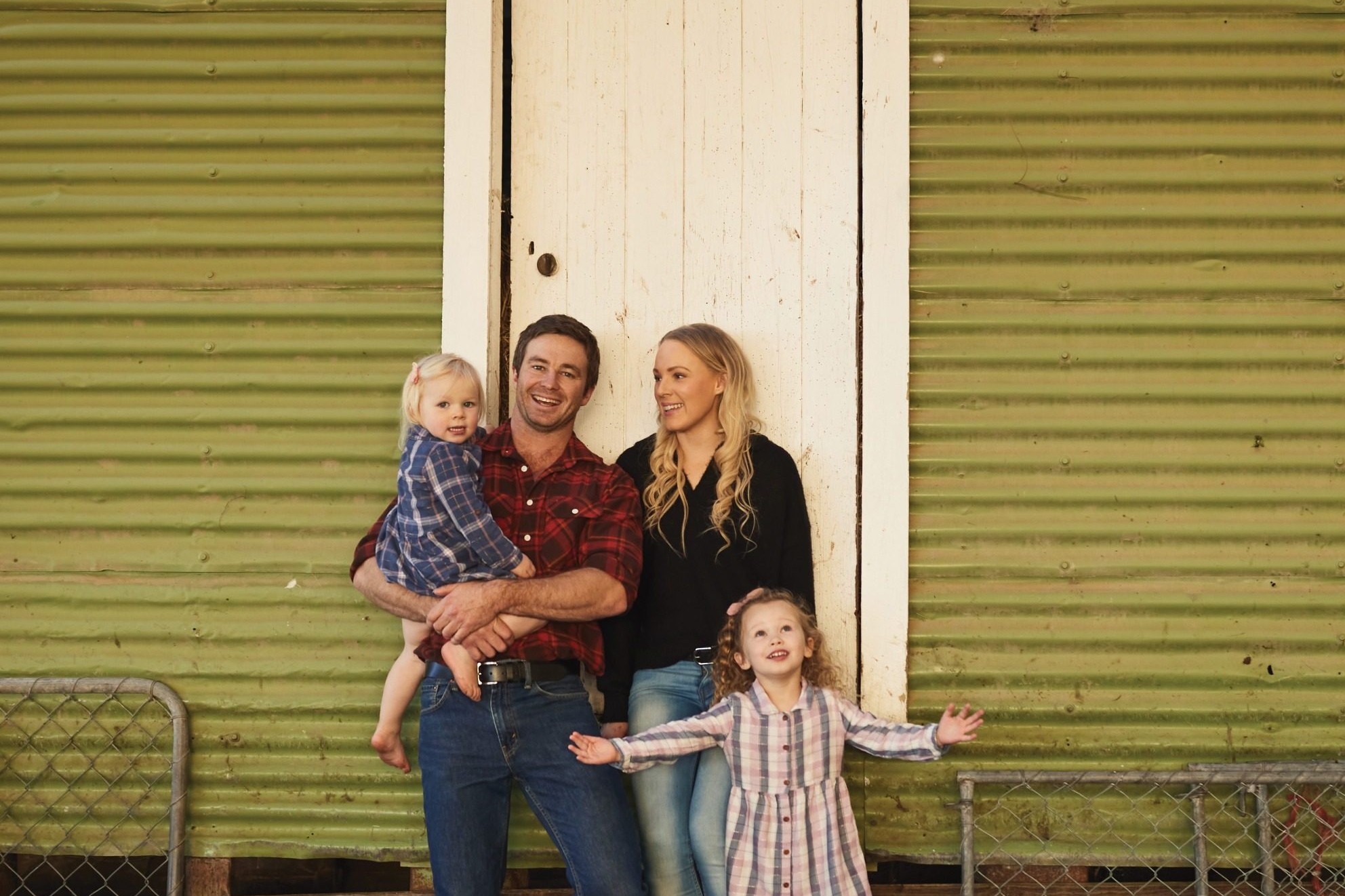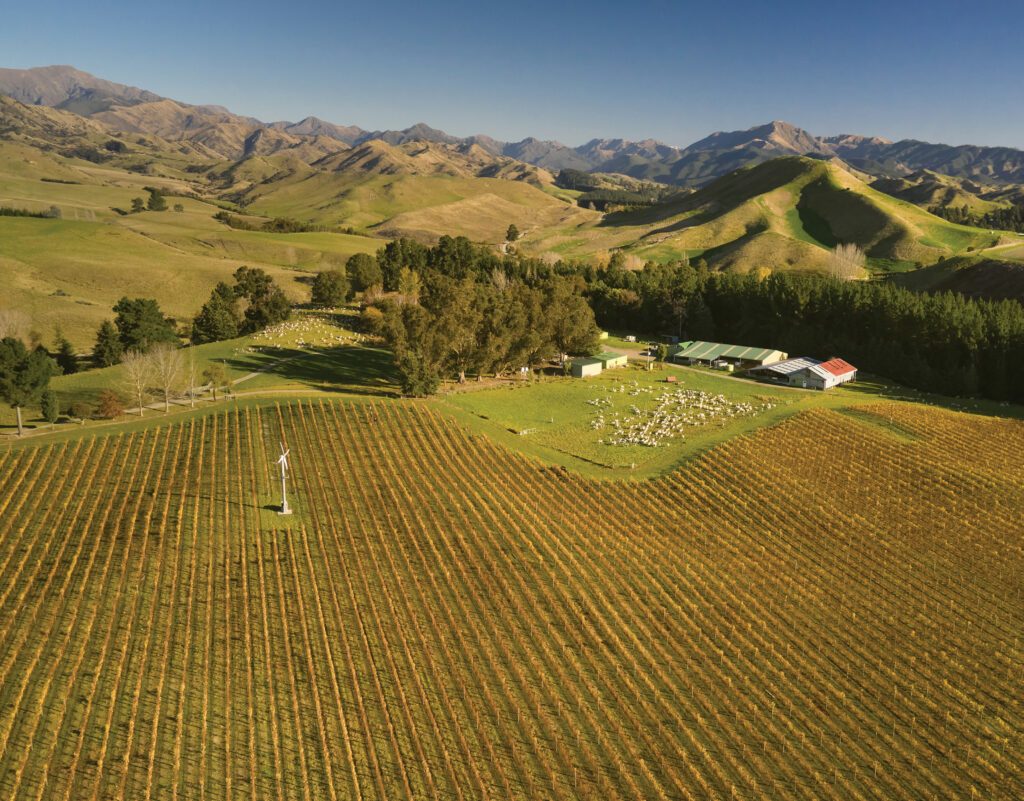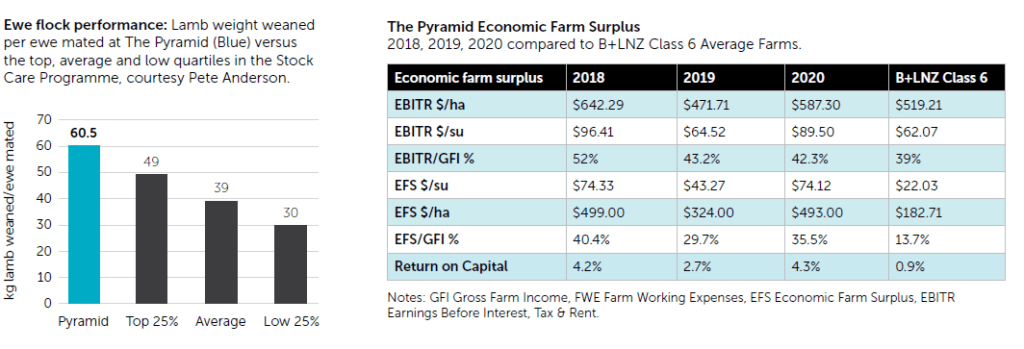Challenging the status quo
The ewe flock is the powerhouse for the Dawkins family’s farming operation in Marlborough’s Waihopai Valley. By Joanna Grigg. Photos by Jess & Paul Jones.

The ewe flock is the powerhouse for the Dawkins family’s farming operation in Marlborough’s Waihopai Valley. By Joanna Grigg. Photos by Jess & Paul Jones.
Chris and Julia were at the helm of The Pyramid from 1978 to 2020. The baton was handed on when the 400ha farming area was leased to their son Richard, and his wife Jess.
The balance is in vineyard (100ha), forestry woodlots (80ha) and aesthetic plantings. Honey and firewood are onfarm ventures that involve the Dawkins’ other sons.
Richard (32) has the same Dawkins inclination to challenge the status quo. As an example, he pioneered a successful system for maximising triplet lamb survival through indoor lambing. His refined system has seen triplet lamb deaths fall from 33% to 17% over lambing. The low 4% mortality across all ewes (in and outdoors) is due to mobs getting more attention across the board. Twinning ewes now lamb in the best paddocks. Triplet lamb survival is 245% from scanning to sale.
“It’s an absolute home run for us and for animal welfare,” Richard says.
In 2021 the net profit farm-wide from the indoor triplet lambing system was over $32,000. This is based on dropping the long-term average death rate of 24% down to 15%.
Their performance was so impressive it won them the Westpac and Osgro Marlborough Sheep & Beef Farmer of the Year 2021.
The farm power house is the ewe flock. While the judging criteria was across five bottom lines, the sheep performance was a standout. Chris and Julia targeted 150% survival to sale and a minimum 15% lamb death. This year Richard’s flock achieved 164%. Lambs are expected to grow to 20kg carcase weight on the ewe, with about 80% to 90% sold prime before weaning.
The Pyramid is slightly wetter than classic dryland Marlborough (783mm average) but the farm is stocked slightly lighter than the typical B+LNZ Class 6 Northern South Island breeding and finishing farm (about 7su/ha versus 8.4). The stock unit income is higher however at $208/su in 2020. This was $50 more than the average farm. The most telling perhaps is that the Pyramid’s earnings before interest, tax and rent (EBITR) is 44% higher than the B+LNZ Class 6 average.
Behind this performance are ewes that some might call too heavy but competition judge, Pete Anderson, described as exceptionally efficient. The 1400 Longdown ewes average 79kg at mating. All 400 hoggets are mated as they typically weigh in at 48 to 50kg.

At 60.5kg of lamb liveweight weaned/ewe mated, the flock is well above the StockCare programme top 25% of 49kg. The lambing was 160% plus combined with an average weaning weight of 38kg to get this result. The ewes weaned 77% of their body weight that year. Anderson says these ewes grow big lambs and the Dawkins are on top of ewe and lamb wastage. Ewe wastage is an exceptional 4%, compared to the top 25% of Stock Care flocks at 4.6%. In 2020 the lamb wastage was 14.5%, while the average for StockCare mobs was 19%.
Longdowns Stud has supplied the Dawkins rams for eight years. The Dawkins will cull ewes anytime, and often find a second udder check will catch another 4% with faults. Chris says he sees huge room for improvement in hogget lambing. It sits about 90% and has been affected by abortion. The hogget lambs grow just as fast as lambs from older ewes. This is due to the trifecta of being terminal sires, a later lambing date and having more singles – 80% are killed prime before weaning.
This season the hoggets were lambed indoors as well, to try and maximise those lambs that made it full term. Richard says he was able to reduce dystocia and starvation, losing only 9% of lambs born.
EBITR has averaged over $560/ha for the past three years and the effective farm surplus beats the B+LNZ Class Six model hands down – an impressive $493/ha in 2020 versus $182/ha.
Richard puts the good lamb growth rates down to concentrating on ewe body condition. Anything lower than three out of five at weaning gets lucerne or brassica through summer. The target is reaching over 3.5 for mating on March 1st. They frequently body score and take the lighter ewes out, even when mustering. Through the yards they score by eye, especially when off-shears.
Chris says the Marlborough sunshine is very conducive to sheep performance, especially helping keep ewes healthy and in good condition over summer.
Richard says they can graze rougher pastures and keep weight on with maintenance rations.
Ryegrass is dominant on the downs and needs controlling. Sub-clover has a good presence, especially on the hill and white clover performs almost as an annual, with a seedbank present.

Jerseys for hire
The Dawkins use dairy genetics three ways in their system.
They run Friesian bulls through to R2s for fattening, grow Jersey bulls for lease to dairy farmers and fatten carry-over cows to be resold into the dairy industry in calf.
The cattle:sheep ratio is 45:55 and cattle are valued for sucking up sheep parasite larvae and grooming pastures. Ewe lambs were only drenched once last season, as an indication of flow-on benefits.
Cattle onboard can range from 35 to 500. They are the relief valve in the feed budget. With bull numbers constant (about 230) numbers are then manipulated depending on the season and whatever is the best value for money.
A Jersey bull at The Pyramid has an exciting life compared to the typical Friesian bull destined for hamburgers. They are bought in as bull calves for $450 and leased as yearling bulls for heifer mating on dairy farms in late October. They return in January.
Richard says they are lucky to have an outstanding stock agent, who adds considerable value in this area.
The lease is repeated as R2s where they are used for mixed age cow mating, then return home for a third winter They then go back for mating but are sold to the dairy farmer at that point.
Each Jersey bull sold this year made $2650 after commission. Richard says they are only counted as four stock units/year since they go off the farm for a time. This puts the return about $180/stock unit/ year. They are more profitable per unit of energy eaten than Friesian bulls, he says. Friesian bulls sometimes compete with sheep, eating better pastures like ryegrass or brassica crops on the flat. The Jersey bulls will spend winter on the Tummil hill on ranker pasture.
Forage King Maize, sourced through OsGro Seed, provides bulk feed for the low demand cattle (Jersey bulls or carry-over cows through summer). The Dawkins rate it highly as it needs less water to produce as much biomass as lucerne or wheat. The seed is large and can be planted deeper into the moisture zone. Last season it cost $800/ha to establish and produces between 8 to 12 tonnes/ha. At ten tonnes/ ha this gives a feed cost of eight cents per kilogram of dry matter.
“It’s a far superior option when compared to supplements.”
Pugging and wastage are generally not an issue in the summer so it can be cell grazed, with shifts twice a week. Chris suggests crushing the crop down where the polywire will run, to prevent shorts.

No cost spared to develop hill
Richard and Chris Dawkins have enjoyed the challenge of bringing a weedy hill block into better pasture.
With vineyard development encroaching on the sheep land, the Dawkins purchased a neighbouring 187ha of hill in 2015. It added space for 375 stock units (su) straight away and, after development, now winters 1140su (seven su/ha).
Being a timber man, Chris saw an opportunity in the 200 large scattered wilding pines on the block. Quotes for harvesting were “excessively expensive” so he dry-hired a bulldozer with a winch and a log loader. One of the Dawkins’ long-term workers is an accredited forestry logger, so he did the job himself, with assistance from the Dawkins as required.
Each tree averaged four tonnes of saleable logs, a total of 820 tonne) and, after all expenses, generated $31,000 of profit. At this point Richard and Jess came back from overseas and saw an opportunity in the 150t of non-export grade logs stacked in the corner. The firewood business was born.
Some of the hill has gone back into Pinus radiata, with a 23ha erosion-prone spot planted as a woodlot. Poplars were planted along the roadside for shelter. Other weeds on the block were barberry, hawthorn and broom. They were aerial sprayed and root raked using a custom-made rake that plucked out the barberry bushes.
In typical Dawkins style, things were done properly. A 1.5km rock causeway road has allowed two wheel drive access across the hill. The wetter areas were drained with 2.5km of Nova flow pipe. Fencing repairs are underway and four km of new fencing installed with plans for a reticulated water system too.
Super sulphur 20 was applied at 1500kg/ha with three tonnes of lime by truck to the lower country. The pH is now six and Olsen P 30. Annual fertiliser maintenance is 150kg super/ha (about $9/su).
To help buffer from drought, an 80,000kg drymatter silage pit has gone in. It can feed ewes and two-tooths prior to mating if required and resulted in 195% scanning through dry periods in recent years.

Praised for matching land to use
The first thing you notice at The Pyramid are the trees; the lovely scattered oak, popular, and Honey Locusts (Gleditsia) trees and the areas of well-manicured woodlots. Next you notice the big pointy hill in the centre of the farm that gives it its name. Across this landscape are a patchwork of pastures and crop blocks.
This careful match of land type to use was recognised by the judges in the Marlborough Farmer of the Year Competition. The Dawkins scored highly in the land resource management section (ranking number two of all past entrants). Lachie Grant, LandVision, said they had a positive attitude to the environment and were proactive in minimising pugging.
“Pug your soils down and the top is so compressed it can only hold fifteen mls of moisture – that’s gone in only three days in the summer.”
Grant questioned the recent root raking on the hill, however, describing it as a tool to be used cautiously. Richard says they used this method as the Jordan soils are heavy and stable and there was minimum soil disturbance.
“And a one pass operation with the rake is the most effective.”
Nitrogen losses are 8kg N/ha/year (considered low for sheep/beef). The Dawkins are part of the Avon Valley Catchment Group and have started water quality testing.
It wouldn’t be downland Marlborough without a good dollop of lucerne in the system. The Dawkins have close to 20% in direct grazed lucerne and typically 20ha in winter fodder crops. This forms part of the pasture renewal system. Lucerne balage is bought in as a supplement.
Richard said the winter dormancy of lucerne is an issue as it can’t be stocked until mid-September.
“It’s great for later-lambing hoggets but the main ewes have to lamb on winter-active mixed sward pastures.”
He said they need complementary pastures that grow through winter, to get ewes through early lactation. Lambing starts late July onwards. Main weaning is November, to beat the dry and meet the peak markets.
As a new thing in 2022, Richard will introduce a wintering system with no intensive winter grazing.
The harder slopes are in Pinus radiata and Chris values the lump sum income. A recent woodlot made $60,000/ha net profit but it is still not enough for Chris to replace livestock.
“I have to feed the family between the 36 years of harvests.
“I like a diverse income stream.”
He was always keen on wool, especially when it made up 55% of farm income. Now it’s 1.4% and the “pride and joy” Corriedales made way, somewhat reluctantly, for meat-focus Longdowns.
Richard really rates the breed as a way to achieve mating to weaning of 165%.
Indoor lamb a worthwhile beat
Richard Dawkins had 10 years away from the family farm. While away he experienced indoor lambing systems in the United Kingdom and on return, decided the continual battle with triplet lambs out in the paddocks couldn’t go on.
With support from Beef + Lamb NZ, the Dawkins created an indoor lambing system in the covered yards, tweaking it each year to decrease labour and input costs.
Out in the paddock, usually one triplet lamb would be lost of the three during pre-lamb and lambing process.
Now only 15% to 18% of triplets die, Richard says, and this is saving the majority of all preventable deaths.
“These remaining deaths are either related to stillbirth and other non-preventable issues,” Richard says.
The improvement in wastage has helped see the Dawkins achieve a lamb percentage of 165% this season.
Richard calls it a hybrid indoor-outdoor system, as the ewes only spend two to seven days in the indoor pens. Ram harnesses and markers means conception patterns are tracked and ewes are all set to come indoors, in their groups.
“Sheep are used to being handled so have adapted really well.”
The original intention was to address an animal welfare issue, rather than make money.
“The bonus is that the system is now profitable.”
In 2021,120 triplet ewes, 198 single ewes and 141 hoggets were lambed through the shed. The cost was $19.10/head which provided a profit of about $7000.
But when the wider benefits across the whole lambing system were taken into account (extra feed outdoors, labour savings with lambing beat) the farm-wide profit was an extra $32,000. Richard has managed to reduce the labour cost and had time to shift winter breaks, as well as be in the shed each day.
“The system is easier and less labour intensive than some may think”.
The boxer
Richard and Jess have two children (Ellie, four and Rosalee, two). Richard was a keen welter and middleweight boxer in his 20s but decided to step back from sport to focus on family and farming. His boxing highlight was being runner up in the 2018 National Champs, in a close-fought battle.




